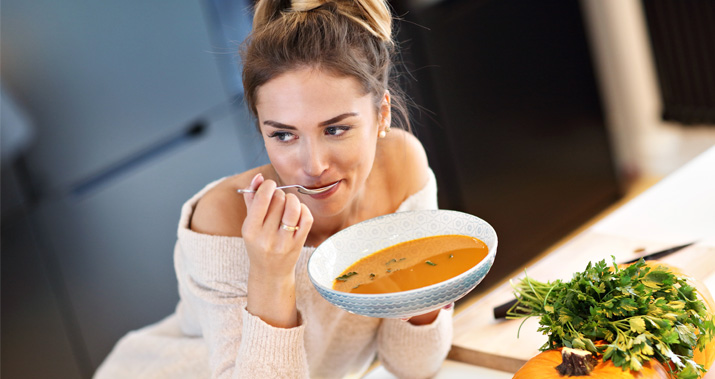
It’s that time of year again, when it seems like everything comes in a pumpkin spice version. While pumpkin spice products generally don’t contain any actual pumpkin, it’s good to know how the pumpkin fruit itself can help support your health journey. By cooking with fresh or canned pumpkin, you can achieve your weight loss goals without having to sacrifice seasonal flavors.
Pumpkin: a Nutrient-Dense Food
Pumpkin flesh is “nutrient-dense.” This means that it contains a lot of vitamins and minerals for relatively few calories. One cup of cooked pumpkin puree is only about 50 calories, but is packed with beta carotene, vitamin C, potassium, copper, manganese, vitamin B2, vitamin E, and iron. In addition to being loaded with micronutrients, pumpkin is high in fiber and water — two things that help keep you feeling fuller for longer. As long as you use it wisely, you can indulge in pumpkin dishes without contributing a significant calorie load to your diet.
Pumpkin seeds, while higher in fat and calories, are also very high in protein and minerals. One cup of pumpkin seeds contains 285 calories, 12g of fat, 2.3g of saturated fat, 588mg of potassium, 12g of fiber, and 12g of protein, as well as 42% of the RDA of magnesium, 11% of iron, and 3% of calcium.
Pick the right pumpkin.
If you don’t have the time to cook your own pumpkin, don’t worry — canned is fine. Just be sure to choose canned pumpkin, and not canned pumpkin pie filling. There are a few key differences between the two. For one, canned pumpkin pie filling is pre-seasoned, so all you need to do is add a few binders and pour it in a crust to make a pie. This makes it much less versatile when it comes to adding it to recipes or substituting it for other ingredients. Pumpkin pie filling is also usually sweetened, which means it’s higher calorie and contains more simple carbohydrates. Save the extra sugar and make sure you’re purchasing plain canned pumpkin. The ingredients should not list anything other than pumpkin.
Try substituting pumpkin for other ingredients.
Are you making a cake or bread recipe that calls for butter or oil? Some low-fat cooks substitute applesauce, but pureed pumpkin works just as well. It adds moisture to baked goods, while adding less sugar than applesauce and increasing the fiber content. If you or your family have a hard time fitting enough servings of vegetables into your diet, pureed pumpkin is an easy way to sneak in some extra.
Use pumpkin seed butter.
Pumpkin seeds can be turned into butter just like other nuts and seeds. Instead of using regular butter on toast and other baked goods, try spreading on a little pumpkin seed butter. You’ll get more protein, minerals, and flavor, and less fat. For best results, choose either plain pumpkin seed butter, or varieties that are flavored with small amounts of salt, cinnamon, or other seasonings. Skip the ones with added sugar.
Keep pumpkin seeds for on-the-go snacking.
Pumpkin seeds in the shell are just as good as trail mix or other nut mixes when you need to curb your hunger with a quick, energy-boosting snack. Best of all, you can even eat the shells for some added fiber and fullness.
Use pumpkin as a soup or sauce base.
Many of the best autumn and winter soups and sauces are creamy and comforting, but not great for your waistline (or your cardiovascular health). You can substitute pumpkin for a portion of the milk or cream and create a dish that’s just as satisfying, but lower in fat and calories and higher in micronutrients. Try adding pumpkin, nutmeg, and sage to your favorite Alfredo recipe — it makes for an unforgettably delicious pasta dish.
One of the most fun, least expensive ways to eat healthfully is indulging in seasonal fruits and vegetables. Since it’s in season right now, see where you can swap some of low-calorie, high-nutrient pumpkin into your diet, and enjoy all of the flavor and health benefits it has to offer.